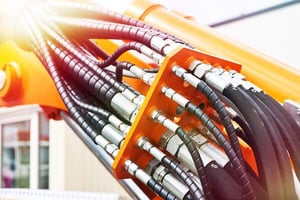 A hydraulic system acts as a power source to generate energy, producing force and/or motion. Choosing the correct hydraulic hose fitting type ensures safe and satisfactory system performance. Fitting selection involves the consideration of various factors, including fitting-to-hose compatibility and the suitability of one-piece or two-piece fitting designs for the assembly. The correct fitting and hose combination is crucial to ensure optimal hydraulic system performance.
A hydraulic system acts as a power source to generate energy, producing force and/or motion. Choosing the correct hydraulic hose fitting type ensures safe and satisfactory system performance. Fitting selection involves the consideration of various factors, including fitting-to-hose compatibility and the suitability of one-piece or two-piece fitting designs for the assembly. The correct fitting and hose combination is crucial to ensure optimal hydraulic system performance.
One-piece hose fittings
One-piece hose fittings have a pre-clamped ferrule made specifically for hose fittings. This feature ensures the collar will not be able to slip out of alignment. This style allows hose fittings to be properly matched to the hydraulic systems. These one-piece joints make it easy to perform routine maintenance without increasing the risk of leakage.
One-piece hose fittings are also excellent for basic, low-pressure applications and allow for quick hose assembly. This style of hydraulic hose fitting is a great foolproof option with a wide selection of shapes and end formations. One-piece hose fittings also have excellent hose compatibility.
Two-piece hose fittings
Two-piece fittings offer greater flexibility in hose selection and connection. Additionally, they can accommodate a variety of hoses by providing multiple fitting and ferrule options, including 1SN, 2SN and multi-spiral hoses, tailored to specific applications. For enhanced corrosion resistance and extended service life, stainless steel 316 two-piece hydraulic hose fittings are recommended, particularly in chemical and offshore applications. End users may require hose fitting manufacturers to provide material traceability, as well.
These hydraulic hose fittings are suitable for critical and high-pressure applications, especially when extreme hose vibration or pressure surges are possible.
Two-piece hose fittings ensure a strong assembly in severe operating conditions. In most high-pressure applications, the hose should be skived or double-skived to create a secure metal-to-metal internal and external connection.
Standard and interlock hose tails
Carrying stainless steel two-piece hose fittings and one-piece hose fittings can give distributors different benefits. The cost of inventory can be significantly reduced because only two types of hose tail styles need to be inventoried: standard and interlock.
Having a limited number of hose tails that vary in size and end connections can be cost effective for distributors looking to cover most hoses and applications. Carrying a limited stock of hose fittings makes it easier and more organized for distributors.
Standard hose tails can be used in a broad range of applications, including textile hoses, one- and two-wire braided hoses, four-spiral hoses, thermoplastic hoses and PTFE hoses.
Interlock hose tails are oftentimes used with higher-pressure multi-spiral hoses and in mechanically stressful environments. They create a strong connection between the hose and fitting where there is frequent high pulsating pressure.
Cost considerations
The cost of stainless ferrules is far less than their compatible hose tails. The key is to maintain a well balanced inventory of hose tails with a large variety of compatible ferrules.
Carrying a profitable balance of ferrules and hose tails allows distributors to lower costs while still maintaining the inventory customers require. This can prove to be very important when there is a desire to reduce the carrying costs of expensive stainless steel components.
Conclusion
Proper hydraulic maintenance is crucial to ensure a long service life of the system and its components. This includes regular checks for leakage, fitting displacement or damage. By implementing scheduled inspections and maintenance procedures, hydraulic fittings can perform at their peak, preventing damage to the hydraulic system.
Ultimately, selecting the correct hydraulic hose fittings, installing them correctly, practicing routine maintenance and optimizing inventory management contributes to the overall performance, service life and economies of hydraulic systems.
This blog is an excerpt from our latest white paper titled "Hydraulic Hose Fittings: Four Things to Consider". Click here or the link below to download!
Primary Sources Include:

